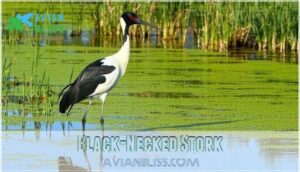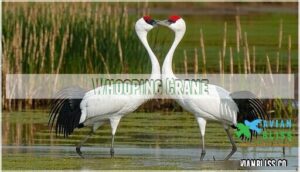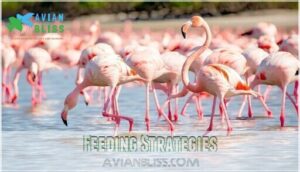This site is supported by our readers. We may earn a commission, at no cost to you, if you purchase through links.

These fascinating creatures use their extended necks for reaching food in deep water, spotting danger from far away, and showing off during mating season.
Think of flamingos filtering tiny shrimp, herons spearing fish like skilled fishermen, or ostriches scanning African plains for predators.
Each species has perfectly adapted its neck length to match its lifestyle.
From wetland waders to grassland giants, these birds prove that sometimes bigger really is better in terms of survival.
The secret lies in understanding how their unique anatomy reveals feeding opportunities others simply can’t reach.
Table Of Contents
- Key Takeaways
- Birds With Long Necks
- Evolution of Long Necks
- Habitat Preferences
- Feeding Strategies
- Conservation Challenges
- Frequently Asked Questions (FAQs)
- What is a long necked bird?
- Do birds have long necks?
- What bird has a slender neck?
- Where can I spot birds with long necks and legs?
- What are long-necked and long-legged birds?
- What bird has a long neck and a curved bill?
- What is a tall bird with a long neck?
- What is a skinny white bird with a long neck?
- What is a big brown bird with a long neck?
- What is a big GREY bird with a long neck?
- Conclusion
Key Takeaways
- You’ll find that birds with long necks use their extended anatomy as nature’s ultimate multi-tool – reaching food in deep water, spotting predators from far distances, and performing elaborate courtship displays that other birds simply can’t achieve.
- You can identify these specialized hunters by their impressive 13-25 neck vertebrae (compared to humans’ seven), which gives them incredible flexibility to strike prey with lightning speed and scan their surroundings like living periscopes.
- You’ll discover these remarkable birds thriving in specific habitats – wetlands and marshes for herons and cranes, grasslands for ostriches, and coastal areas for egrets – where their neck length provides crucial survival advantages.
- You’re witnessing conservation challenges that threaten these species, from habitat destruction and climate change to pollution, making protection efforts essential for birds like whooping cranes that’ve recovered from near-extinction through dedicated conservation work.
Birds With Long Necks
You’ll find that birds with long necks have developed these features to reach food in deep water, tall grass, and high places that other animals can’t access.
These remarkable birds stretch their necks like nature’s periscopes, accessing hidden treasures other creatures can only dream of reaching.
These remarkable birds possess between 13 and 25 neck vertebrae, which is much more than the seven vertebrae that humans have, allowing them to move their heads with incredible flexibility and precision.
American Flamingo
You’ll spot the American Flamingo standing out among longnecked birds with its vibrant pink coloration earned through diet influence on carotenoid pigments.
This flamingo species thrives in wetland habitats, showcasing remarkable adaptations for survival. Their vibrant plumage also signifies uniqueness and confidence.
Three distinctive features that make this bird unforgettable:
- S-Shaped Neck – Perfect for underwater bird feeding while filtering algae and small crustaceans
- Monogamous Nature – Pairs bond for life, performing synchronized courtship dances together
- Nesting Behavior – Builds cone-shaped mud towers in shallow waters for protection
Black-Necked Stork
You’ll find the Black-Necked Stork towering at five feet tall across Australian wetland habitats.
This striking member of the stork family displays bold black and white plumage that catches your eye instantly.
Their stork anatomy includes an impressive 8.2-foot wingspan perfect for soaring.
Watch them wade through marshes, using precise stork behavior to spear fish and frogs with their sharp bills.
Great Blue Heron
The Great Blue Heron stands as North America’s most recognizable wading bird.
You’ll spot this majestic creature measuring up to 4.5 feet tall with an impressive 6.5-foot wingspan.
These patient hunters use specialized hunting techniques, remaining motionless before striking fish with lightning speed in wetland habitats.
- Physical Characteristics: Blue-gray plumage, black shoulder patches, and distinctive yellow-orange bill make identification easy
- Hunting Techniques: Stands perfectly still in shallow water, then strikes prey with rapid neck extension
- Nesting Habits: Builds large stick nests in tall trees, often forming colonies called rookeries
- Regional Variations: Northern populations migrate south, while southern birds remain year-round residents
- Conservation Status: Stable populations recovered from DDT-era declines through protection efforts
Whooping Crane
Standing five feet tall with distinctive red crowns, whooping cranes represent one of North America’s greatest conservation success stories.
These towering giants prove that dedicated conservation efforts can bring species back from the brink of extinction.
These majestic birds with long necks nearly vanished in the 1940s, but dedicated crane recovery efforts have increased their population to about 600.
You’ll witness their elaborate mating rituals during spring, featuring synchronized dancing and trumpeting calls that echo across wetland habitats for miles.
Ostrich
You’ll be amazed by the ostrich, Africa’s towering giant that dominates the savanna landscape.
These flightless birds showcase incredible bird anatomy with necks stretching up to three feet long. Their impressive ostrich size reaches nine feet tall, while their ostrich speed hits 45 mph when running from predators.
Here’s what makes ostriches remarkable:
- Ostrich eggs weigh three pounds each – equivalent to 24 chicken eggs combined
- Ostrich diet includes plants, seeds, and small animals they swallow whole
- Ostrich behavior involves complex social groups and elaborate mating dances
Evolution of Long Necks
You’ll find that long necks in birds developed over millions of years to solve specific survival challenges.
These extended necks provide clear advantages for feeding in deep water, spotting predators from far away, controlling body temperature, and attracting mates during breeding season, which can be considered a key aspect of breeding.
Foraging Advantages
You’ll notice how neck length gives these birds a serious edge when hunting.
Their extended reach boosts feeding efficiency by 75%, letting them snag prey other birds can’t touch.
This bird anatomy adaptation reduces resource competition while enabling diet specialization.
Long necks support diverse bird feeding strategies, from underwater probing to precise prey capture, making these feeding habits incredibly effective.
These birds possess many cervical vertebrae, allowing for a greater range of motion, which enhances their feeding efficiency and supports diverse feeding strategies.
Predator Detection
Long bird necks work like watchtowers in the wild.
You’ll notice how these adaptations give birds serious survival advantages when danger lurks nearby.
Here’s how long necks boost predator detection:
- Visual Acuity – Extended height provides panoramic views of surroundings
- Neck Mobility – Cervical vertebrae allow 360-degree scanning without body movement
- Height Advantage – Elevated position spots threats from greater distances
- Alert Postures – Flexible necks enable quick directional changes during hunting
- Group Vigilance – Collective neck flexibility enhances flock security systems
Thermoregulation
During hot days, birds with long necks use their extended anatomy for thermoregulation through blood vessel regulation and behavioral adaptations.
The increased surface area ratio helps dissipate heat efficiently, while neck feather insulation provides protection during cold weather.
Environmental factors influence how these birds position their necks to control body temperature, making their cervical vertebrae essential for survival.
Some parrot species also face challenges related to avian evaporative cooling during heat waves.
Courtship Displays
You’ll witness spectacular mating rituals when birds with long necks show off for potential partners.
These courtship displays feature dramatic neck movements, synchronized dances, and impressive vocalizations that demonstrate fitness.
Display variations range from flamingo head-flagging to crane unison calls.
Partner selection depends heavily on posture significance – how gracefully a bird can arch, twist, and present its elongated neck during these enchanting performances.
Habitat Preferences
You’ll find these long-necked birds in four main environments that provide the perfect conditions for their feeding and nesting needs.
Each habitat offers specific advantages, from shallow waters in wetlands where herons can wade and hunt fish, to open grasslands where ostriches can spot predators from miles away.
Wetlands and Marshes
Wetland habitats serve as nature’s nurseries for wading birds and aquatic birds seeking abundant food sources.
You’ll find tall birds like herons and cranes thriving in these water-rich environments where marsh biodiversity supports their hunting needs.
These ecosystems require wetland conservation efforts to maintain water quality and habitat restoration, as avian dependence on these areas remains critical for survival.
To further protect birds, consider using protective feeding solutions in these sensitive habitats.
Grasslands and Savannas
You’ll find some remarkable long-necked species thriving in open grasslands and savannas.
These expansive habitats offer perfect conditions for birds like ostriches and Sandhill cranes, where their elevated perspective aids in spotting predators across vast distances.
Restoring degraded habitats is essential for these species.
Key adaptations for grassland survival:
- Savanna Bird Diets feature seeds, insects, and small mammals
- Grassland Nesting occurs in ground scrapes or low vegetation
- Migration Patterns follow seasonal rainfall and food availability
Coastal Areas
Coastal environments attract numerous wading birds whose long necks help them thrive along shorelines.
You’ll spot Great Blue Herons and egrets using their extended necks to hunt in shallow tidal pools.
These shorebirds adapt their feeding behaviors to combat saltwater intrusion and marine pollution.
Many people decorate their gardens with heron-themed lawn ornaments.
However, coastal erosion threatens their nesting sites, making habitat conservation essential for bird migration patterns.
Forests and Woodlands
Long-necked birds thrive in forest canopy environments where their height advantage shines.
These woodland specialists have developed unique camouflage strategies and nesting habits that make them forest champions:
- Herons blend seamlessly with tree bark patterns
- Ibis species contribute to vital seed dispersal
- Storks provide natural insect control services
Their feeding habits perfectly complement forest ecosystems.
Feeding Strategies
You’ll discover that long-necked birds use their extended necks as specialized tools to reach food sources other animals can’t access.
Their feeding methods include filter feeding like flamingos, spearing fish like herons, grazing on plants like ostriches, and hunting underwater prey with precise neck movements.
Filter Feeding
Flamingos showcase nature’s most impressive filter anatomy, using specialized bills to strain tiny organisms from water.
You’ll watch them sweep their heads side to side, creating efficient water filtration systems that capture food particles with remarkable filter efficiency.
This feeding behavior offers evolutionary advantages, allowing these birds with long necks to thrive in shallow waters where other species can’t compete effectively, demonstrating a clear example of evolutionary advantages.
Probing and Spearing
While filter feeders sift through water, other birds with long necks prefer precision hunting.
You’ll watch herons demonstrate lightning-fast strike speed as they spear fish with razor-sharp accuracy.
Their specialized beak morphology acts like a fishing spear, while neck extension provides the perfect angle for prey capture.
Ibis and spoonbill species showcase similar spear fishing techniques, making feeding behaviors remarkably efficient in shallow waters.
Grazing and Browsing
You’ll find that some birds with long necks have developed remarkable dietary adaptations for plant-based feeding.
Ostriches showcase unique foraging behavior as they stretch their necks to reach high vegetation and fruits.
Their specialized digestive systems efficiently process tough plant material.
These feeding habits demonstrate how nutritional intake varies dramatically among different species, with plant preferences shaping their survival strategies.
Aquatic Hunting
You’ll witness incredible precision when watching wading birds hunt in aquatic ecosystems.
Great blue herons demonstrate remarkable strike speed, using their neck flexibility to spear fish with lightning accuracy.
Their specialized beak morphology enables diverse hunting techniques, from patient stalking to rapid strikes.
These feeding habits showcase how long necks provide essential advantages for prey specialization in water environments.
Some species also exhibit various water-based feeding techniques.
Conservation Challenges
You’ll discover that many long-necked birds face serious threats from habitat destruction, pollution, and climate change.
These challenges put species like whooping cranes and flamingos at risk, making conservation efforts essential for their survival.
Habitat Loss
You’ll notice that Wetland Destruction poses the biggest threat to these magnificent birds.
Agricultural Expansion eliminates vital breeding grounds, while Urban Encroachment fragments their territories.
Coastal Development destroys nesting sites where herons and egrets raise their young.
Deforestation Effects ripple through ecosystems, leaving eighty-nine long-necked species fighting for survival as their wetland habitats vanish beneath human progress.
Supporting bird habitat restoration can help mitigate these environmental issues.
Climate Change Impacts
Climate change disrupts everything these magnificent birds depend on.
Rising temperatures cause migration shifts, forcing species to travel different routes or distances.
Breeding changes occur when seasonal timing no longer matches food availability.
Extreme weather destroys nests and reduces survival rates.
Wetland habitats shrink from drought, creating food scarcity that threatens entire populations across their ranges.
Birds face challenges due to phenological sensitivity to climate change.
Human Disturbance
You’re witnessing human activities create serious environmental challenges for long-necked birds.
Noise pollution from construction disrupts their communication, while hunting impacts reduce populations dramatically. Tourism effects stress nesting colonies, and habitat fragmentation isolates breeding grounds.
These human disturbances threaten conservation efforts nationwide.
Here’s how human activities affect these magnificent birds:
- Boat engines and aircraft – Loud noises scare birds from critical feeding areas
- Construction projects – Heavy machinery destroys nesting sites and breeding grounds
- Recreational activities – Hikers and photographers disturb sensitive roosting areas
- Urban development – City lights confuse migrating flocks during nighttime flights
- Agricultural expansion – Farm equipment fragments wetland habitats into smaller patches
Pollution and Contamination
Chemical pollution poses serious threats to long-necked birds across their wetland habitats.
Pesticide exposure weakens immune systems, while heavy metals accumulate in tissues.
Oil spills coat feathers, destroying insulation, and plastic ingestion blocks digestive systems, causing starvation.
Acid rain alters water chemistry in bird habitats, and these environmental challenges require immediate attention for effective bird conservation efforts, to address the serious threats and ensure the well-being of the birds, which is crucial for their survival, thus effective conservation is necessary.
Frequently Asked Questions (FAQs)
What is a long necked bird?
You’ll recognize a long-necked bird by its extended cervical vertebrae, typically 13-25 bones compared to mammals’ seven.
These adaptations help birds like herons, cranes, and flamingos reach food in deep waters or detect predators effectively, which can be considered a key adaptation.
Do birds have long necks?
You’ll find birds don’t all sport lengthy necks like giraffes do.
Many species have developed remarkably long necks for feeding and survival.
Herons, cranes, and flamingos showcase impressive neck lengths with specialized vertebrae structures.
What bird has a slender neck?
You’ll spot the Great Egret with its remarkably slender, S-curved neck that stretches elegantly as it hunts.
This graceful wader uses its thin neck to strike fish with lightning precision in shallow waters.
Where can I spot birds with long necks and legs?
You’ll discover these elegant waders in wetlands, marshes, shallow lakes, and coastal areas.
Visit national wildlife refuges, state parks with water features, or even urban ponds where herons, egrets, and cranes naturally congregate.
What are long-necked and long-legged birds?
Picture graceful dancers stretching skyward—that’s what you’ll see with long-necked, long-legged birds.
You’re looking at wading species like herons, cranes, flamingos, and storks that use their elegant proportions for hunting in wetlands.
What bird has a long neck and a curved bill?
You’ll find the White Ibis fits this description perfectly.
This elegant wading bird sports a distinctively curved, downward-pointing bill that’s perfectly designed for probing muddy waters and marshes for crabs, fish, and other tasty treats, with its elegant appearance and curved bill being notable features.
What is a tall bird with a long neck?
Like nature’s skyscrapers reaching for the clouds, you’ll recognize the Great Blue Heron standing four and a half feet tall with its elegant neck stretched skyward.
It is perfectly designed for hunting in shallow waters.
What is a skinny white bird with a long neck?
You’re likely seeing a Great Egret or Snowy Egret.
These elegant wading birds have brilliant white plumage and remarkably long necks that help them hunt fish in shallow waters across wetlands.
What is a big brown bird with a long neck?
You’re likely seeing a Great Blue Heron, which stands 3-5 feet tall with grayish-brown plumage.
These wading birds frequent wetlands, marshes, and lakeshores, using their long necks to strike fish with lightning speed.
What is a big GREY bird with a long neck?
A graceful giant you’ll often spot is the Great Blue Heron.
You’ll recognize this majestic bird by its blue-gray plumage, impressive four-foot height, and distinctive long neck that helps it hunt fish in shallow waters.
Conclusion
Like masterful architects building towers, birds with long necks have perfectly engineered their bodies for survival success.
You’ve seen how these remarkable species use their extended necks to access food sources, detect threats, and thrive in diverse habitats.
Whether you’re watching flamingos filter-feed or cranes scan wetlands, you’re witnessing millions of years of evolution.
Next time you spot these graceful creatures, you’ll appreciate the incredible adaptations that make their long necks essential survival tools.














